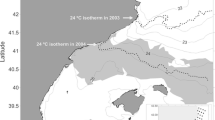Abstract
We tested three hypotheses concerning the timing of spawning for a circumpolar species, capelin (Mallotus villosus), for which timing of larval emergence is known to be synchronized by physical conditions. The first hypothesis, developed from previous studies, was that spawning would be synchronized by upwelling events. Initial results from Middle Cove Beach in eastern Newfoundland indicated that spawning was not synchronized with upwelling. We next hypothesized that spawning was a function of several environmental variables. Results from logistic regression indicated that neither single-factor nor multi-factor models could explain the timing of spawning. Single variables could predict spawning in some years but no variable could reliably predict the time of spawning year after year. Finally, we hypothesized that the probability of spawning increased as a set of significant variables approached preferred levels. For capelin at Middle Cove, the set of variables that influence capelin spawning were identified as wave height, sea surface roughness and capelin abundance in the water. Thus only a combination of variables explained the timing of spawning for capelin. Preferred conditions for capelin spawning were wave heights less than 20 cm at the beach, a sea surface with a slight ripple, and an intermediate rank abundance of capelin in the water corresponding to hundreds to thousands of individuals. Capelin abundance alone was not a useful predictor. During the course of the study we observed a shift in the dates that capelin arrived and spawned at the beach. During 1987–1990 capelin spawned at Middle Cove Beach during June, but in more recent years (1991–1993) capelin did not arrive or spawn until July.
Similar content being viewed by others
References
Berenbeium DY, Sigaev IK (1977) On correlation between the water temperature and the spawning times for Georges Bank herring. Int Comm Northwest Atl Fish Res Doc 77/VI/42:1–6
Blaxter JHS, Hunter JR (1982) The biology of the clupeoid fishes. Adv Mar Biol 20:1–223
Bond CE (1979) Biology of fishes. Saunders, Philadelphia
Brummett AR (1966) Observations on the eggs and breeding season ofFundulus heteroclitus at Beaufort, North Carolina. Copeia: 616–620
Carscadden JE, Frank KT, Miller DS (1989) Capelin (Mallotus villosus) spawning on the southeast shoal: influence of physical factors past and present. Can J Fish Aquat Sci 46:1743–1754
Chadwick EMP, Claytor RR (1989) Run timing of pelagic fishes in the Gulf of St. Lawrence: area and species effects. J Fish Biol 35 [Suppl A]:215–223
Cox DR (1970) The analysis of binary data. Halsted Press, New York
Frank KT, Leggett WC (1981) Wind regulation of emergence times and early larval survival in capelin (Mallotus villosus). Can J Fish Aquat Sci 38:215–223
Frank KT, Leggett WC (1982) Coastal water mass replacement: its effect on zooplankton dynamics and the predator-prey complex associated with larval capelin (Mallotus villosus). Can J Fish Aquat Sci 39:991–1003
Jeffers GW (1931) The life history of the capelinMallotus villosus (O.F. Müller). PhD Thesis, University of Toronto
Laevascu T, Hayes ML (1981) Fisheries oceanography and ecology. Fishing News Books, Farnham
Longhurst AR (1971) The clupeoid resources of tropical seas. Oceanogr Mar Biol Annu Rev 9:349–385
Mertz G, Helbig JA, Colbourne E (1994) Revisiting Newfoundland capelin (Mallotus villosus) recruitment: is there a wind effect? J Northwest Atl Fish Sci 17:13–22
Messieh SN, Moore DS (1979) On the possible effect of the Canso Causeway on the herring fishery. Fish Mar Serv Tech Rep 834:28–42
Moyle PB, Cech JJ Jr (1988) Fishes: an introduction to ichthyology. Prentice-Hall, Engelwood Cliffs, NJ
SAS Institute (1985) SAS user's guide: statistics, version 5 edition. Cary, NC
Schneider DC, Methven DA (1988) Response of capelin to wind-induced thermal events in the southern Labrador current. J Mar Res 46:105–118
Scott WB, Crossman EJ (1973) Freshwater fishes of Canada. Fish Res Board Can Bull 184:1–306
Scott WB, Scott MG (1988) Atlantic fishes of Canada. Can Bull Fish Aquat Sci 219:1–731
Shackell NL, Carscadden JE, Miller DS (1994) Migration of prespawning capelin (Mallotus villosus) as related to temperature on the northern Grand Bank, Newfoundland, ICES J Mar Sci 51:107–114
Shapiro DY, Sadovy Y, Mcgehee MA (1993) Size, composition, and spatial structure of the annual spawning aggregation of the red hind,Epinephelus guttatus (Pisces, Serranidae). Copeia: 399–406
Sleggs GF (1933) Observations upon the economic biology of the capelin (Mallotus villosus O.F. Müller). Rep Newfoundland Fish Resource Comm 1:1–66
Stergiou KI (1989) CapelinMallotus villosus (Pisces: Osmeridae), glaciations, and speciation: a nomothetic approach to fisheries ecology and reproductive biology. Mar Ecol Prog Ser 56:211–224
Taylor MH, DiMichele L (1980) Ovarian changes during the lunar spawning cycle ofFundulus heteroclitus. Copeia: 397–399
Templeman W (1948) The life history of the capelin (Mallotus villosus O.F. Müller) in Newfoundland waters. Bull Newfoundland Gov Lab 17:1–151
Templeman W (1966) Marine resources of Newfoundland. Fish Res Board Can Bull 154:1–170
Vlaming VL de (1972) Environmental control of teleost reproductive cycles: a brief review. J Fish Biol 4:131–140
Author information
Authors and Affiliations
Corresponding author
Rights and permissions
About this article
Cite this article
Therriault, T.W., Schneider, D.C. & Methven, D.A. The timing of spawning in capelin (Mallotus villosus Müller) at a coastal location in eastern Newfoundland. Polar Biol 16, 201–207 (1996). https://doi.org/10.1007/BF02329208
Received:
Accepted:
Issue Date:
DOI: https://doi.org/10.1007/BF02329208




